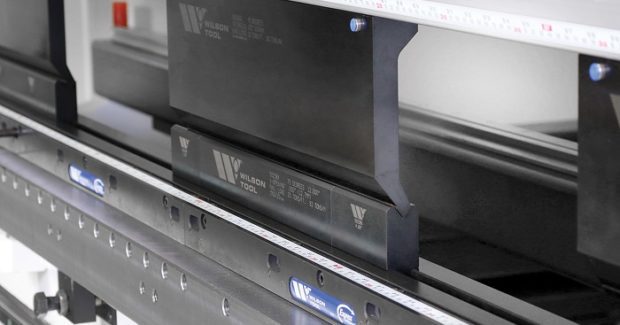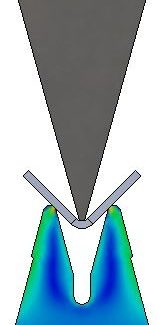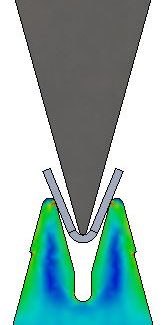Understanding Press Brake Tooling Tonnage Ratings and Calculations
There are various ways to measure tonnage capacity in press brake tooling, so it’s important to look beyond the tooling catalog when doing comparisons to really understand the numbers being displayed. Understanding the units of measure most commonly used to measure tonnage capacity is a crucial first step.
Posted: October 24, 2018
Selecting the right press brake tooling for your application requires careful consideration of not only how much tonnage a job requires, but how much tonnage your press brake and tooling can safely withstand. Exceeding the maximum allowable tonnage could result in significant damage to the part, the press brake, or the tooling itself. In a worst-case scenario, too much force can put the press brake operator in danger of serious injury. You may be surprised to learn that not all tooling and clamping manufacturers use the same method to calculate tonnage capacity. As a result, it is not uncommon for the exact tooling profile to be rated with what appears to be different maximum tonnage ratings. Although material quality and heat treatment do play into the strength factor, the different methods of tonnage calculation seem to create the most confusion. For the safety of your operators, the longevity of your tooling and the success of your bending operation, it’s important to understand how the tonnage capacity of your tooling is calculated and applied.
STANDARD UNITS OF MEASURE
Over time the methods of measuring force have evolved, with several continuing to be used by the fabrication industry today. The following are conversion rates for the most commonly used units of measure:
U.S. Short Ton/Foot (T/ft): 2,000 lb/ft = 29.2 kN/m
Metric Ton/Foot: 1,815 lb/ft = 26.5 kN/m
Imperial Long Ton/Foot: 2,240 lb/ft = 32.7 kN/m
Metric Ton/Meter: 2,204 lb/m = 1,000 kg/m = 9.81 kN/m
kN/Meter: 224.8 lb/m = 1 kN/M
For example, looking at the conversion chart pictured above, if a tool was rated at 81 tons per foot with short tons/foot (imperial) and the same unit was measured with 73 long tons/foot (metric), the strength would actually be the same but the short ton rating would appear stronger.
HOW BENDING FORCE IMPACTS TONNAGE RATINGS
When considering the tonnage capacity for a particular bending operation, it is important to note that the amount of force generated by bending is not constant during the bending cycle. The greatest amount of force is needed at the beginning of the cycle to “brake” the material as forces shift toward a vertical load (Figure 1). As the material continues to bend, tonnage will reduce a bit (Figure 2) and then spike again when the bottom of the die is engaged and forces have shifted to a horizontal load (Figure 3). Since most die breakage happens later in the stroke, it is important to know that tooling is rated at the bottom of the stroke, rather than the top. Tools that are rated at the bottom of the stroke will appear to be weaker when in fact they could be stronger. The images below show how the tonnage is displaced as the angle changes in the bend. As you can see, it could make a big difference if you rated tooling at 90 deg versus 30 deg on a 30 deg die. Dies are not always rated at the included angle.
CONVERT TONNAGE RATINGS TO MAKE AN EQUAL COMPARISON
To safely and accurately assess tonnage capacity when the ratings provided are at different angles, you must convert the tonnage rating to make an equal comparison. In the example shown below, if Die A is a 10 mm, 30 deg die with the V rated at 60 T/m when bending at 90 deg, and Die B is rated at 46 T/m when bending at 30 deg, it appears that Die A is stronger than Die B. However, you’ll notice Die A and Die B are rated at different angles, which affects the tonnage rating. The more acute the rating, the more force is concentrated in an outward direction.
FACTOR IN SAFETY
What isn’t known from one manufacturer to the next is how safety is factored in to the tonnage rating of their tooling. Most reputable tooling manufacturers will have the safety of the operator in mind when rating tooling. However, the best way to ensure the safety of your operators when determining the tonnage requirement for any application is to never, ever exceed the manufacturer’s maximum allowable tonnage. Remember, just because the die doesn’t break the first time the tonnage capacity is exceeded doesn’t mean it won’t ever break. Each time excess tonnage is put to tooling there is an element of fatigue. As the tooling fatigues due to excess tonnage, it will eventually crack.
As you can see, there are various ways to measure tonnage capacity in press brake tooling, so it’s important to look beyond the tooling catalog when doing comparisons to really understand the numbers being displayed. Understanding the units of measure most commonly used to measure tonnage capacity is a crucial first step. In order to safely use any tooling it’s important to also be mindful of other factors that may impact load limits, including the tool’s material, thickness, length, surface treatment and bending method. Never begin any bending operation without factoring in all the necessary calculations to determine the load limit of the tooling as well as the press brake machine. The best bend is a safe bend.









